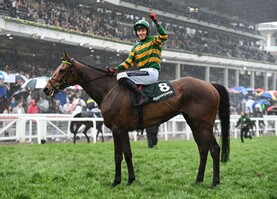Last week’s Punchestown Festival was generally regarded as very successful.
Attendances were up and there was a greater spread of success among owners, trainers and jockeys than normal, almost certainly because the Willie Mullins team was a little weaker due to the stable’s increased activity in Britain in recent weeks.
A couple of hours before the five-day meeting got underway, Horse Racing Ireland [HRI] invited industry stakeholders and the media to a bar at the racecourse to witness the launch of HRI’s five-year Strategic Plan. If you are involved in the racing business, the 24-page document is worth checking out on hri.ie.
The plan
Equine welfare, recruitment of industry staff, increasing public engagement and improving financial sustainability at all levels of the industry for participants are some of the key areas HRI intends to address.
The plan focuses heavily on HRI’s social responsibility to industry employees, the horses and the environment.
Arguably the two biggest projects on HRI’s checklist is the construction and opening of a second all-weather racetrack at Tipperary, and the redvelopment of the Irish Equine Centre [IEC] at Johnstown in Kildare.
The Tipperary project is on-track to open by 2027 though it could actually be racing (without a grandstand) by 2026. Planning permission has been secured and the next step is to put out a tender for the supply of the synthetic surface the horses will be racing on.
The Equine Centre project involves a total revamp of the laboratory which was opened in 1983. The IEC tests samples from horses and stables all over the country, checking for disease outbreaks. Their brief is “protecting the health and wellbeing of Ireland’s horse population”.
Their work is universally respected but the facility is very aged. The build cost for the redevelopment is approximately €16 million. An investment in upgrading the lab could pay immediate dividends as, at the moment, all samples taken in Irish racing are sent to a more modern British lab for testing. A modernised IEC could win that annual €1.5m contract.
Another strand of HRI’s welfare agenda is to give more backing to Treo Eile, the not-for-profit organisation which connects retired racehorses with new owners.
What HRI wants to achieve by 2028
Grow racing’s annual economic value from €2.46bn to €3bnIncrease number of fixtures from 395 to 430Increase attendances by 10% from 1.23m to 1.36mIncrease prize money from €69.4m to €80mIncrease Government funding from €76m to €92.4Irish Equine Centre redeveloped by 2027Support Treo Eile to double the number of horses it handles per yearReduce the number of equine racecourse fatalities annually40% gender balance on HRI boards/committees by 2025Increase the number of international owners with horse in training in Ireland by 25%New ‘people training campus’ to be operational by 2028Tipperary all-weather track to be open by 2027IRE Incentive scheme to grow by at least 20%
Last week’s Punchestown Festival was generally regarded as very successful.
Attendances were up and there was a greater spread of success among owners, trainers and jockeys than normal, almost certainly because the Willie Mullins team was a little weaker due to the stable’s increased activity in Britain in recent weeks.
A couple of hours before the five-day meeting got underway, Horse Racing Ireland [HRI] invited industry stakeholders and the media to a bar at the racecourse to witness the launch of HRI’s five-year Strategic Plan. If you are involved in the racing business, the 24-page document is worth checking out on hri.ie.
The plan
Equine welfare, recruitment of industry staff, increasing public engagement and improving financial sustainability at all levels of the industry for participants are some of the key areas HRI intends to address.
The plan focuses heavily on HRI’s social responsibility to industry employees, the horses and the environment.
Arguably the two biggest projects on HRI’s checklist is the construction and opening of a second all-weather racetrack at Tipperary, and the redvelopment of the Irish Equine Centre [IEC] at Johnstown in Kildare.
The Tipperary project is on-track to open by 2027 though it could actually be racing (without a grandstand) by 2026. Planning permission has been secured and the next step is to put out a tender for the supply of the synthetic surface the horses will be racing on.
The Equine Centre project involves a total revamp of the laboratory which was opened in 1983. The IEC tests samples from horses and stables all over the country, checking for disease outbreaks. Their brief is “protecting the health and wellbeing of Ireland’s horse population”.
Their work is universally respected but the facility is very aged. The build cost for the redevelopment is approximately €16 million. An investment in upgrading the lab could pay immediate dividends as, at the moment, all samples taken in Irish racing are sent to a more modern British lab for testing. A modernised IEC could win that annual €1.5m contract.
Another strand of HRI’s welfare agenda is to give more backing to Treo Eile, the not-for-profit organisation which connects retired racehorses with new owners.
What HRI wants to achieve by 2028
Grow racing’s annual economic value from €2.46bn to €3bnIncrease number of fixtures from 395 to 430Increase attendances by 10% from 1.23m to 1.36mIncrease prize money from €69.4m to €80mIncrease Government funding from €76m to €92.4Irish Equine Centre redeveloped by 2027Support Treo Eile to double the number of horses it handles per yearReduce the number of equine racecourse fatalities annually40% gender balance on HRI boards/committees by 2025Increase the number of international owners with horse in training in Ireland by 25%New ‘people training campus’ to be operational by 2028Tipperary all-weather track to be open by 2027IRE Incentive scheme to grow by at least 20% 





 This is a subscriber-only article
This is a subscriber-only article











SHARING OPTIONS: